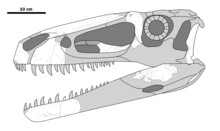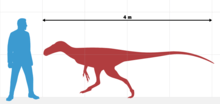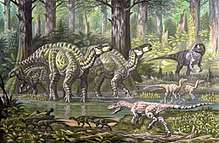Eotyrannus
| Eotyrannus | |
|---|---|
 | |
| Known fossil pieces after Eotyrannus. | |
| Scientific classification | |
| Kingdom: | Animalia |
| Phylum: | Chordata |
| Clade: | Dinosauria |
| Order: | Saurischia |
| Suborder: | Theropoda |
| Clade: | Tyrannoraptora |
| Superfamily: | †Tyrannosauroidea |
| Genus: | †Eotyrannus Hutt et al., 2001 |
| Species: | †E. lengi |
| Binomial name | |
| Eotyrannus lengi Hutt et al., 2001 | |
| Synonyms | |
| |
Eotyrannus (meaning "dawn tyrant") is a genus of tyrannosauroid theropod dinosaur hailing from the Early Cretaceous Wessex Formation beds, included in Wealden Group, located in the southwest coast of the Isle of Wight, United Kingdom. The remains (MIWG1997.550), consisting of assorted skull, axial skeleton and appendicular skeleton elements, from a juvenile or subadult, found in a plant debris clay bed, were described by Hutt et al. in early 2001.[1] The etymology of the generic name refers to the animals classification as an early tyrannosaur or "tyrant lizard", while the specific name honors the discoverer of the fossil.
Description

A number of characters present in the holotypic specimen are unique to the genus. These include: The rostral end of dentary possessing a concave notch housing the most mesial alveolus and a dorsally-directed prong on the rostromesial margin of the notch, curving lateral furrows on the lateral surface of the dentary, a surangular with a hypertrophied gutter-like concavity near the rostrodorsal border, with the caudal end of the concavity containing foramen that perforate the body of the surangular, a low coronoid process on the surangular with a concave area located caudodorsally, and an ulna and radius with a tear-drop shaped cross-section at the mid-shaft.
The holotypic specimen was disarticulated prior to fossilisation, with many elements of its skeleton scattered throughout the assemblage: none of the vertebral column is preserved in articulation and those vertebrae that are preserved consist of separated neural arches and centra, signifying that the holotype was an immature individual.
Due to the relative low-quality preservation of many of the skeletal elements, numerous pieces discovered have been difficult to identify: these include unidentified cranial elements, as well as an “ulna” which has since been recognised as the distal part of the tibia. Before the proper identification of this fragment, Eotyrannus was reconstructed with much longer tibiae, which influenced the early reconstructions of the animal.
Many of the characters also presented as unique to the genus in the diagnosis of Hutt et al. (2001) are in fact widespread throughout Tyrannosauroidea, for example the presence of 'serrated carinae on D-shaped premaxillary teeth' is far from unique to E.lengi. Furthermore, neither the presence of a laterally flattened rostral region to the maxilla nor a pronounced rim to the antorbital fossa are unique to the genus.[2]
The holotype of Eotyrannus is estimated to have measured about 4 m (13 ft) long.
Phylogeny
The discovery of Eotyrannus corroborates the notion that early tyrannosauroids were gracile with long forelimbs and three-fingered grasping hands, although the somewhat large size of the animal either means that early evolution for this clade was carried out at a large size or Eotyrannus developed large size independently.[3] The find of this animal in Europe puts in question to the purported Asian origin for these animals along with North American Stokesosaurus and European Aviatyrannis arguing for a more complex biogeography for tyrannosauroids.[4]

Below is a cladogram by Loewen et al. in 2013 that includes most tyrannosauroid genera.[4]
| Tyrannosauroidea |
| |||||||||||||||||||||||||||||||||||||||||||||||||||||||||||||||||||||||||||||||||||||||||||||
A recent analysis has found Eotyrannus to be a megaraptoran closely related to taxon like Megaraptor (Porfiri et al., 2014)[5]
| Megaraptora |
| |||||||||||||||||||||
See also
References
- ↑ Hutt, S.; Naish, D.; Martill, D.M.; Barker, M.J.; Newbery, P. (2001). "A preliminary account of a new tyrannosauroid theropod from the Wessex Formation (Cretaceous) of southern England". Cretaceous Research. 22: 227–242. doi:10.1006/cres.2001.0252.
- ↑ Naish, D., 2006. The Osteology and Affinities of Eotyrannus lengi and Other Lower Cretaceous Theropod Dinosaurs From England. Unpublished Ph.D. Thesis, University of Portsmouth.
- ↑ Holtz, T. R. Jr. (1994). "The phylogenetic position of the Tyrannosauridae: implications for theropod systematics". Journal of Paleontology. 68: 1100–1117.
- 1 2 Loewen, M.A.; Irmis, R.B.; Sertich, J.J.W.; Currie, P. J.; Sampson, S. D. (2013). Evans, David C, ed. "Tyrant Dinosaur Evolution Tracks the Rise and Fall of Late Cretaceous Oceans". PLoS ONE. 8 (11): e79420. doi:10.1371/journal.pone.0079420. PMC 3819173. PMID 24223179.
- ↑ Juan D. Porfiri; Fernando E. Novas; Jorge O. Calvo; Federico L. Agnolín; Martín D. Ezcurra; Ignacio A. Cerda (2014). "Juvenile specimen of Megaraptor (Dinosauria, Theropoda) sheds light about tyrannosauroid radiation". Cretaceous Research. 51: 35–55. doi:10.1016/j.cretres.2014.04.007.


